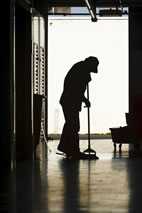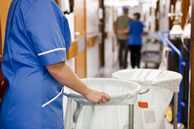CLEANING AND CUSTODIAL SERVICES
Overview
Approximately 2.3 million workers in building custodial services occupations. 1 Projected employment for 2020 is 2.56 million (custodial services). 2 More than 1,400,000 maids and cleaners work in hotels and health care facilities; projected employment is more than 1,500,000. 3
Cleaners perform tasks such as the following:
- Sweeping and mopping floors
- Removing trash
- Cleaning surfaces
- Moving furniture
- Lifting bulk materials
- Disinfecting tasks (health care facilities)
The tasks often result in exposure to these hazards:
- Shiftwork
- Heavy lifting, prolonged standing, and regular bending
- Exposure to body fluids or other infectious agents
- Handling cleaning agents
The hazards may result in conditions such as the following: 4
- Psychosocial stress
- Musculoskeletal disorders
- Infectious diseases
- Dermatologic diseases, allergies, and respiratory diseases


NIOSH supports ongoing research to help cleaners recognize and prevent or reduce risks during their work.
National Occupational Research Agenda (NORA)
NORA is a partnership program that NIOSH maintains with academia, labor, industry, unions, and community organizations to set national research goals for occupational safety and health. The national agenda is developed and implemented through the NORA Sector Councils. The Services Sector has set goals to reduce occupational diseases, injuries, and fatalities among the 66 million persons working in service industries. 5
The National Occupational Research Agenda (NORA) is a partnership program that NIOSH maintains with academia, labor, industry, unions, and community organizations to set national research goals for occupational safety and health. The national agenda is developed and implemented through the NORA Sector Councils. The Services Sector has set goals to eliminate occupational diseases, injuries, and fatalities among the 65 million persons working in service industries through a focused program of research and prevention. To view the agenda for the Services Sector, including the Building Services and Accommodations Subsectors, visit https://www.cdc.gov/niosh/nora/sectors/serv/agenda.html
- BLS [2011]. Occupational outlook handbook: janitors and building cleaners (summary). http://www.bls.gov/ooh/building-and-grounds-cleaning/janitors-and-building-cleaners.htm
- BLS [2011]. Occupational outlook handbook: janitors and building cleaners (job outlook). http://www.bls.gov/ooh/building-and-grounds-cleaning/janitors-and-building-cleaners.htm#tab-6
- BLS [2011]. Occupational outlook handbook: maids and housekeeping cleaners. http://www.bls.gov/ooh/building-and-grounds-cleaning/maids-and-housekeeping-cleaners.htm
- Charles LE, Loomis D, Demissie Z [2009]. Occupational hazards experienced by cleaning workers and janitors: a review of the epidemiologic literature. Work 34:105‒116
- BLS [2011]. Labor force statistics from the Current Population Survey. http://www.bls.gov/cps/cpsoccind.htm
Resources
- Page last reviewed: June 4, 2014
- Page last updated: June 4, 2014
- Content source:
- National Institute for Occupational Safety and Health Education and Information Division


 ShareCompartir
ShareCompartir